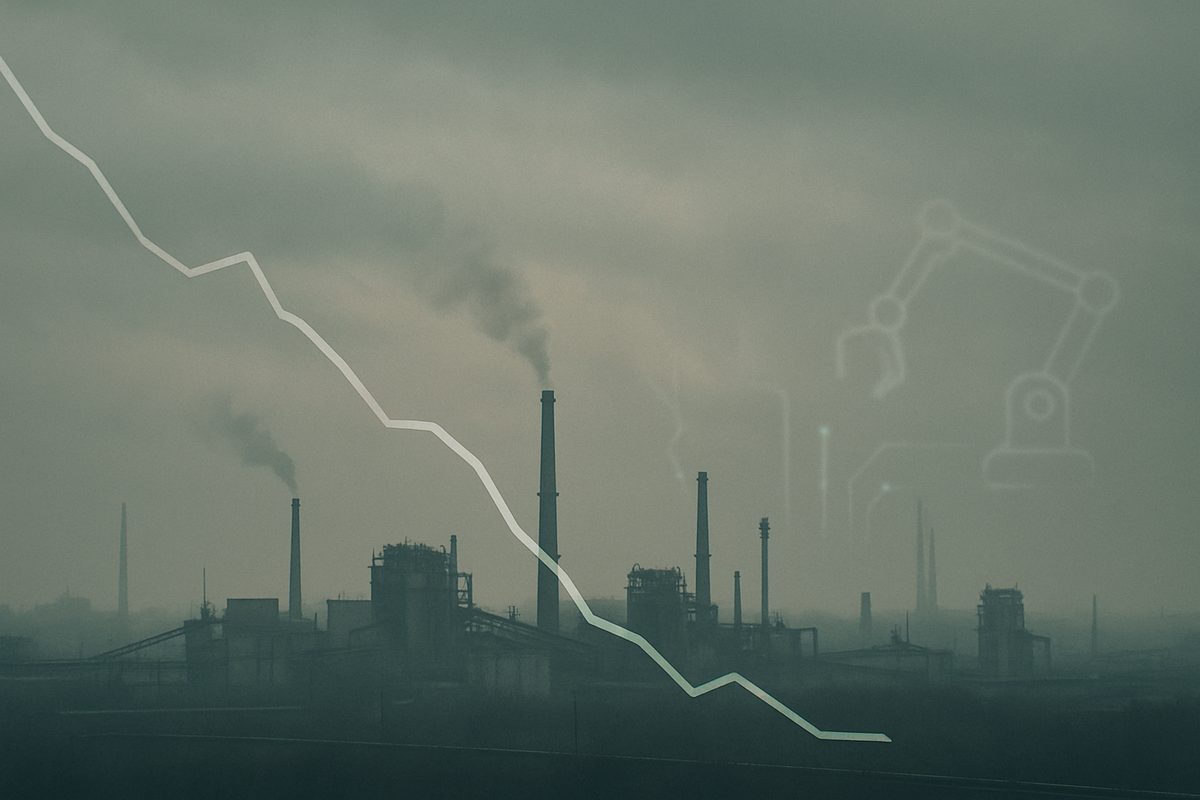
WASHINGTON D.C. – October 21, 2025 – A concerning report from investment giant Vanguard has cast a long shadow over the U.S. labor market, revealing that job growth plummeted to a mere 0.1% for seven of the first nine months of 2025. This alarming deceleration, with September 2025 hitting a paltry 0.09%, marks the slowest sustained pace of job creation since the dark days of the 2009 Great Recession, raising serious questions about the nation's economic trajectory.
The data, derived from Vanguard’s extensive network of 401(k) plans, provides a stable and timely view of employment trends, bypassing the often-revised government statistics. The consistent sub-0.1% growth rate is a stark contrast to the 0.36% peak observed as recently as August 2022, suggesting a significant and widespread cooling of hiring activity across all age groups, with younger workers experiencing a particularly noticeable slowdown. While low layoff rates and solid income growth for those currently employed offer a veneer of resilience, analysts warn that the underlying labor market is increasingly fragile, teetering on the edge of broader economic stagnation.
A Deep Dive into the Stalling Labor Engine
Vanguard’s findings paint a picture of an economy struggling to generate new employment opportunities at a meaningful rate. For seven out of the first nine months of 2025, the U.S. economy effectively flatlined in terms of job creation, a phenomenon not witnessed for such a prolonged period since the aftermath of the 2008 financial crisis. This "slow hiring, slow firing" environment, as termed by U.S. Bank, indicates that while companies are not shedding jobs en masse, they are equally reluctant to expand their workforces.
The implications are profound. Investopedia has characterized Vanguard's report as an "ominous sign," drawing direct parallels to the job market conditions that defined the Great Recession. While the current situation does not mirror the catastrophic monthly job losses of hundreds of thousands seen in 2009 (e.g., 818,000 jobs lost in January 2009, with unemployment peaking at 10.0% in October 2009), the sustained near-zero growth signifies a deep underlying weakness. Harvard economist Jason Furman estimated that excluding the outsized contributions from specific high-tech sectors like data centers and information processing technology, U.S. GDP growth would have been only 0.1% on an annualized basis in the first half of 2025. This suggests that much of the broader economy is already experiencing stagnation or near-recession conditions, with technological advancements masking a more pervasive economic malaise.
The Conference Board's August 2025 Leading Economic Index also reflected this weakening, noting a rise in unemployment claims and a decline in average weekly hours in manufacturing. This confluence of data points suggests that the U.S. economy, despite pockets of strength, is facing a significant challenge in maintaining robust employment and overall growth, placing immense pressure on policymakers to address the burgeoning fragility.
Corporate Fortunes in a Faltering Job Market
A sustained period of minimal job growth will inevitably create a challenging landscape for many public companies, while paradoxically offering opportunities for others. The ripple effects will be felt across sectors, compelling businesses to adapt or risk being left behind.
Companies and Sectors Likely to Suffer:
The Consumer Discretionary sector is particularly vulnerable. With job uncertainty and potentially stagnant wages, consumers are likely to pull back on non-essential purchases. Airlines like Delta Air Lines (NYSE: DAL), hotel giants such as Marriott International (NASDAQ: MAR), and homebuilders like D.R. Horton (NYSE: DHI) could see demand wane as big-ticket spending and leisure travel are curtailed. Retailers, especially those outside of the discount segment, will also face headwinds as consumers prioritize necessities.
The Staffing Industry will experience direct and severe impacts. Firms like Robert Half International (NYSE: RHI), ManpowerGroup (NYSE: MAN), and Adecco Group (OTC: AHEXY) thrive on robust hiring. A "job freeze" environment will translate into decreased demand for both temporary and permanent placements, leading to reduced revenues and increased competition. Historically, the staffing industry has seen significant revenue declines during economic downturns, and 2025's trends suggest a similar contraction.
Certain segments of the Traditional Technology Sector may also face difficulties, particularly those reliant on rapid growth and consumer spending for entry-level roles. Companies like Meta Platforms (NASDAQ: META), Alphabet (Google) (NASDAQ: GOOGL), Amazon (NASDAQ: AMZN), and Microsoft (NASDAQ: MSFT) have already undertaken significant staff reductions, and a further slowdown in hiring could impact their consumer-facing divisions and the demand for non-essential tech products. Manufacturing, construction, and oil & gas sectors have also shown recent job losses or little hiring activity, making them susceptible to further weakness.
Companies and Sectors That May Benefit or Show Resilience:
Conversely, the push for efficiency in a slow-growth environment will benefit the Automation and Artificial Intelligence (AI) Sector. Businesses will accelerate investments in AI and automation to cut costs and boost productivity. Companies at the forefront of AI, such as Nvidia (NASDAQ: NVDA) (for hardware and platforms), Microsoft (NASDAQ: MSFT) (for AI software, cloud services, and enterprise solutions), and Amazon (NASDAQ: AMZN) (for warehouse automation and AWS AI services), are well-positioned. Salesforce (NYSE: CRM) has also noted significant productivity gains from AI within its operations.
Select Enterprise Technology providers, offering essential infrastructure, cloud services, and cybersecurity, will remain robust. Cloud platforms like Amazon Web Services (AWS) (part of AMZN) and Microsoft Azure (part of MSFT), alongside cybersecurity firms such as Palo Alto Networks (NASDAQ: PANW) and CrowdStrike (NASDAQ: CRWD), provide critical services that businesses cannot afford to cut, even in leaner times.
Consumer Staples companies, like Procter & Gamble (NYSE: PG), Walmart (NYSE: WMT), Costco Wholesale (NASDAQ: COST), and Coca-Cola (NYSE: KO), are typically defensive investments. Demand for essential goods like food, beverages, and household items remains stable regardless of economic conditions. Similarly, the Healthcare sector, including firms like Johnson & Johnson (NYSE: JNJ) and UnitedHealth Group (NYSE: UNH), provides essential services with consistent demand, often showing resilience during downturns. Utilities such as NextEra Energy (NYSE: NEE) and Duke Energy (NYSE: DUK) also offer stability due to inelastic demand for their services.
Finally, the Multifamily Real Estate sector and suppliers of construction materials could see resilience. High mortgage rates and affordability challenges may push demand towards rental properties, benefiting companies involved in multifamily development.
Wider Significance and Policy Crossroads
The prolonged period of minimal job growth in late 2025 carries profound wider significance for the U.S. economy, hinting at a potential "jobless recovery" or even a move towards stagflation—a challenging combination of persistent inflation and stagnant growth. With inflation anticipated to remain above the Federal Reserve’s 2% target, a weak job market creates a formidable dilemma for policymakers.
The Federal Reserve will likely face immense pressure to cut interest rates. Lowering the federal funds rate makes borrowing cheaper, aiming to stimulate business investment, expansion, and consumer spending, thereby boosting labor demand. Market expectations for late 2025 already lean towards potential rate cuts, with some analysts even contemplating a 50-basis-point reduction if inflation data permits. However, the Fed must delicately balance this with its mandate to control inflation, navigating a "no landing" scenario where inflation remains high despite a slowing economy. Should rate cuts prove insufficient, quantitative easing might re-enter the discussion.
The U.S. Government can respond through fiscal policy. Increased government spending on infrastructure projects (e.g., roads, bridges), expansion of public service programs, or targeted tax cuts could inject much-needed stimulus into the economy and directly create jobs. Enhanced unemployment benefits and robust job training and workforce development programs, such as those under the Workforce Innovation and Opportunity Act (WIOA), would also be crucial to support workers and facilitate re-skilling. Historically, aggressive fiscal policy, as seen during the COVID-19 pandemic, has been effective in rapidly restoring labor markets, while insufficient stimulus, as after the Great Recession, led to prolonged weakness.
Broader industry trends also play a critical role. The accelerating adoption of Artificial Intelligence and automation is transforming the job market, potentially displacing jobs in routine tasks while creating new opportunities in AI-related fields. This necessitates a massive societal effort in upskilling and retraining. Demographic shifts, particularly an aging population, continue to impact labor force participation rates. Furthermore, geopolitical fragmentation and trade policy uncertainties, such as anticipated tariffs, can create economic uncertainty that makes businesses hesitant to invest and hire. This pervasive economic uncertainty, rather than direct AI displacement, is identified as a major driver of the current "job freeze," making policy responses even more complex.
What Comes Next: Navigating the Economic Fog
The immediate future for the U.S. economy, given the 0.1% job growth rate, appears fraught with fragility. In the short term, through late 2025 and early 2026, the economy is expected to remain on a "knife's edge," with growth potentially slowing to around 1.4%. This could lead to a modest increase in the unemployment rate, possibly reaching 4.4%, and further diminish the bargaining power of workers. Small businesses, in particular, may continue to struggle to find and afford qualified candidates for skilled positions, exacerbating labor shortages in specific areas despite overall low growth.
Looking further ahead, beyond 2025, the long-term economic scenarios suggest a gradual recalibration. Job growth is projected to slowly recover from 2026 to 2028, aligning with an anticipated rebound in GDP growth. However, the labor market is unlikely to return to the "overheated" conditions of prior years, settling instead into a more balanced state. Demographic shifts, including slower population growth and an aging workforce, imply that even modest employment gains could lead to a relatively tighter labor market compared to historical norms, as the pool of available workers expands more slowly.
Potential Strategic Pivots for Businesses: To navigate this environment, businesses will need to be agile and strategic. Prioritizing internal talent development through upskilling and reskilling programs will be crucial to strengthen existing workforces and reduce reliance on external hiring. Enhanced employee retention strategies, including competitive compensation and strong company culture, will be vital to minimize turnover. Operational efficiency, embracing automation, and rigorous cost reduction will be paramount for maintaining profitability. Companies must also re-evaluate financial models, focusing on long-term investments over short-term cuts, and explore innovation and diversification of revenue streams to create new market advantages.
Market Opportunities and Challenges: The primary challenge is an increased risk of recession. Persistent inflation coupled with moderating wage growth could erode consumer purchasing power, while ongoing supply chain and geopolitical volatilities add to operating costs. However, opportunities exist, particularly in the Healthcare and Social Assistance sectors, driven by an aging population. The Technological Advancement space, especially in AI-based systems, data processing, and software development, will continue to see significant investment and demand. Businesses can also find success by identifying and catering to specific niche markets, and the demand for upskilling and reskilling services will create opportunities for education and training providers.
Wrap-Up: A Call for Vigilance
Vanguard's report on the anemic U.S. job growth rate in 2025 serves as a critical warning. While not a repeat of the outright job destruction of 2009, the sustained near-stagnation of employment is an ominous sign, pointing to a deeply fragile labor market and a broader economy struggling for momentum. The "slow hiring, slow firing" dynamic, coupled with persistent inflation and geopolitical uncertainties, presents a complex challenge for policymakers and businesses alike.
Moving forward, investors should closely watch the Federal Reserve's monetary policy decisions, particularly any moves towards interest rate cuts, and the U.S. government's fiscal responses. Key economic indicators such as consumer confidence, wage growth, and, of course, monthly job reports will be crucial barometers of the economy's health. Companies that prioritize efficiency, invest in AI and automation, and operate in non-cyclical, essential sectors are likely to demonstrate greater resilience. For others, strategic adaptation, focusing on internal talent development and innovative solutions, will be paramount to navigate the economic fog ahead. The current environment demands vigilance, adaptability, and a clear understanding of the evolving dynamics of the U.S. labor market.
This content is intended for informational purposes only and is not financial advice
















